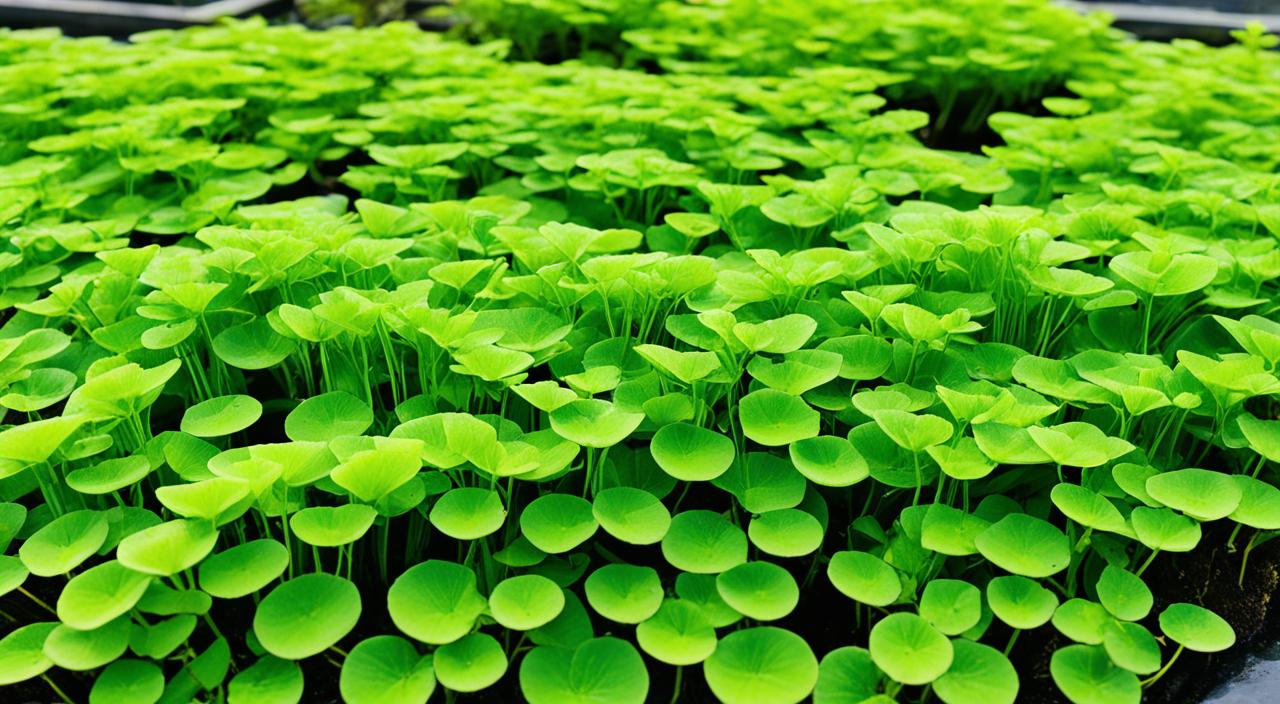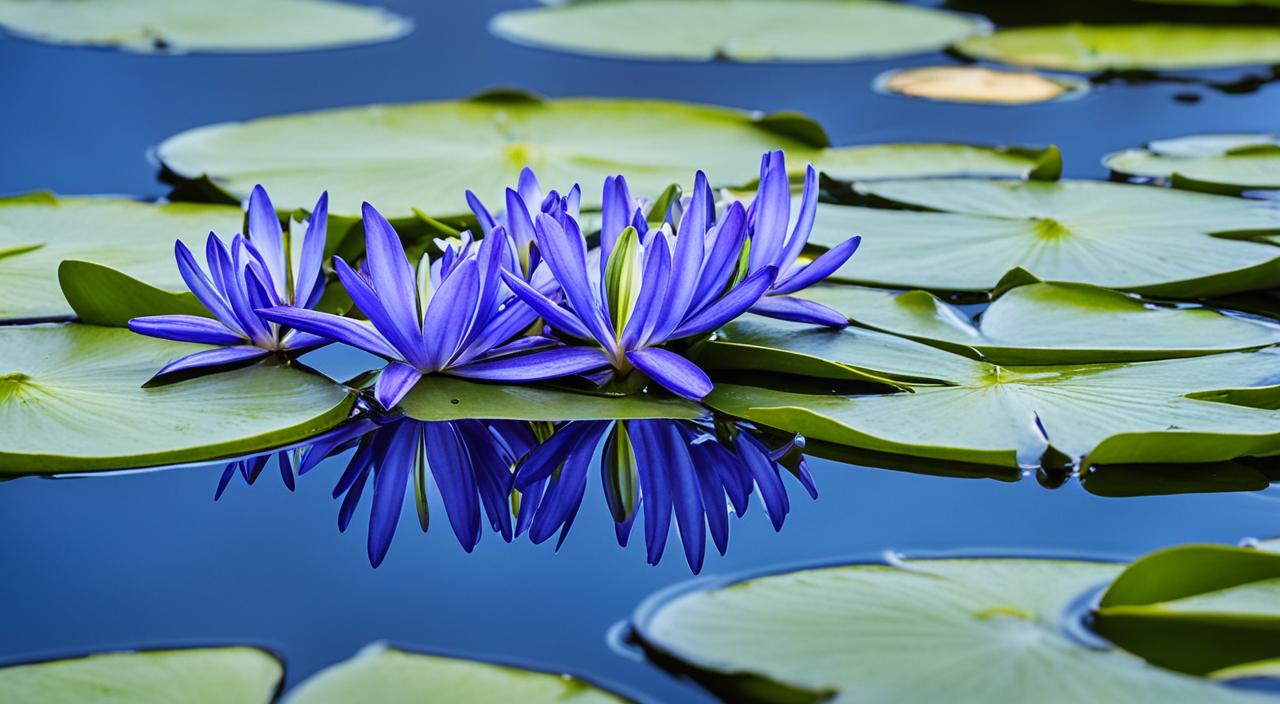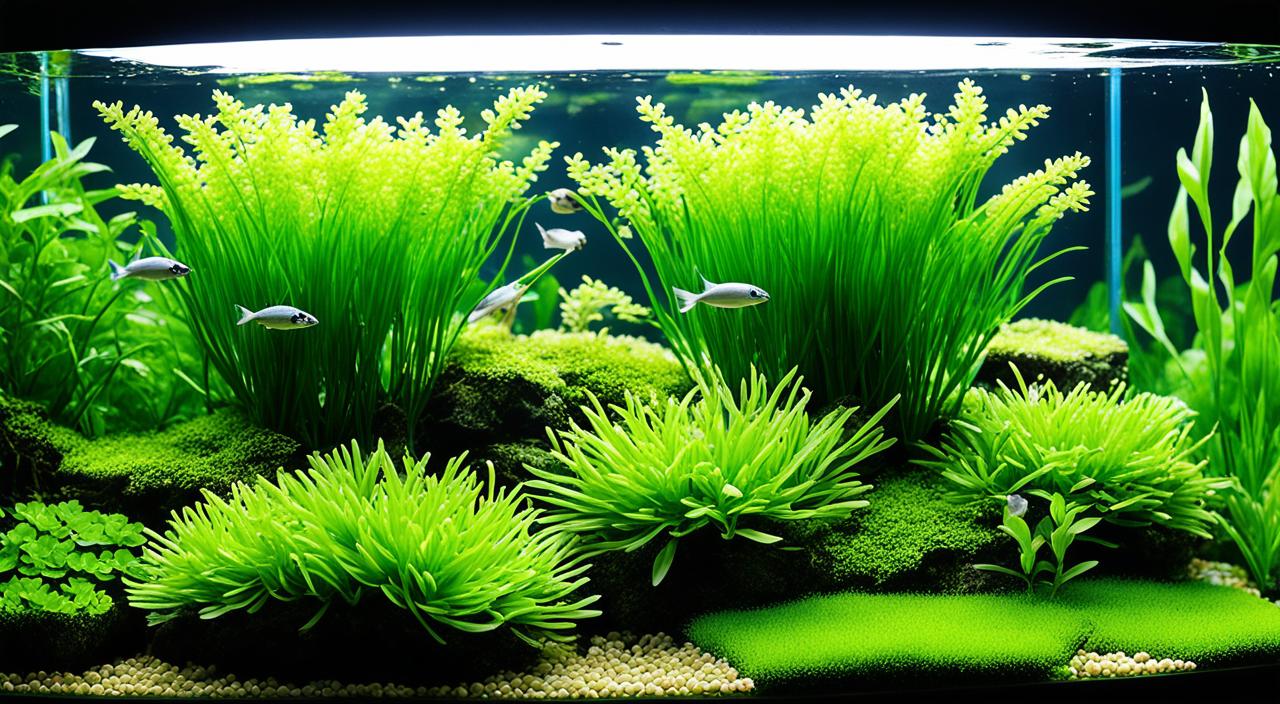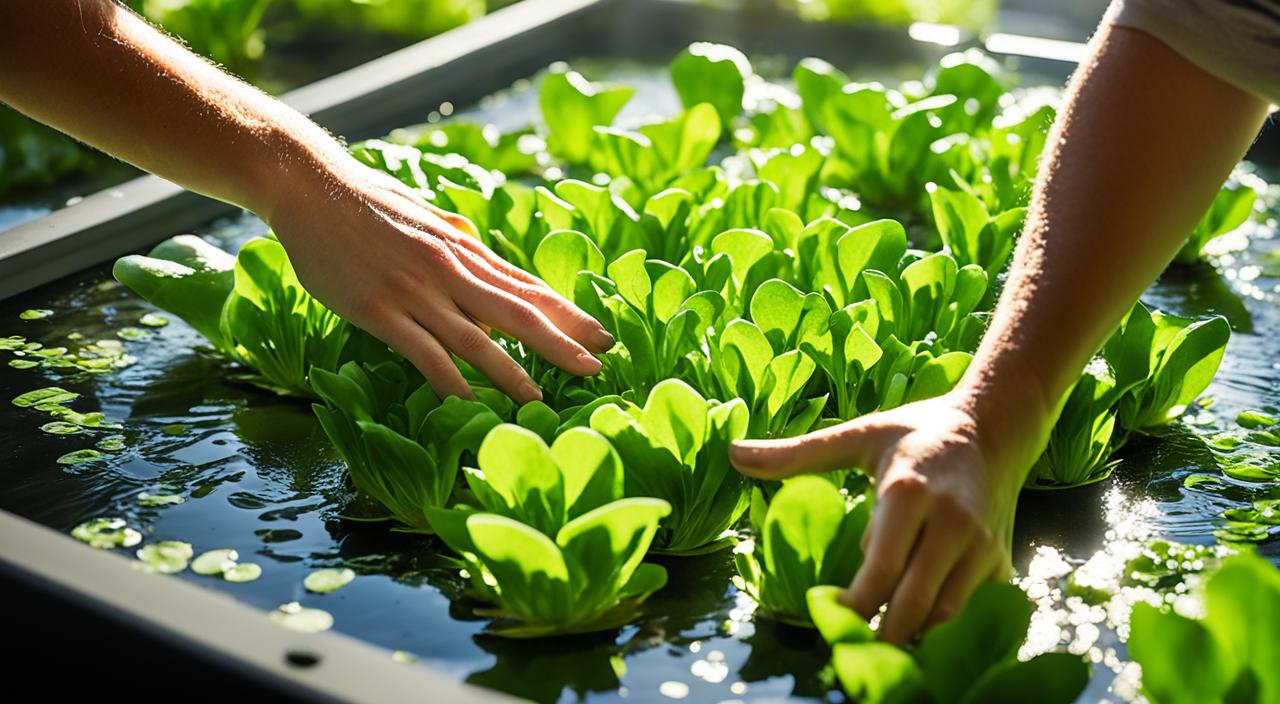Welcome to my guide on Azolla, the aquatic fern that offers incredible benefits for pond plant care. Azolla, also known as Azolla spp., is a versatile biofertilizer and a visually appealing addition to any marine environment. This section will delve into Azolla’s origins, habitat, and essential morphological characteristics. By the end, you’ll have a comprehensive understanding of this remarkable plant and how to care for it in your pond or aquaponics system.
Key Takeaways:
- Azolla is a versatile aquatic fern that is a natural biofertilizer for plants.
- It enhances the growth of plants and improves water quality in ponds and aquaponics systems.
- Azolla is visually appealing and adds beauty to any aquatic environment.
- Understanding Azolla’s origins, habitat, and morphological characteristics is crucial for proper care.
- Proper placement and lighting are essential for the healthy growth of Azolla.
Brief Overview Of Azolla (Azolla spp.)
Azolla is a genus of aquatic ferns that belong to the family Salviniaceae. It is characterized by its small, floating leaves that resemble duckweed or moss. Azolla is a versatile plant with many benefits.
One of the critical benefits of Azolla is its ability to fix atmospheric nitrogen. This makes it a valuable addition to aquaponics systems as a natural fertilizer, providing essential nutrients for plants while reducing the need for synthetic fertilizers. Azolla’s nitrogen-fixing capabilities contribute to the overall health and productivity of the aquaponics system. Additionally, Azolla can be used in ponds and water gardens to control algae growth, as it competes for the same nutrients algae rely on to thrive. Its fast growth and dense coverage can effectively shade the water, reducing the availability of sunlight for algae.
Azolla Species Table:
| Characteristic | Description |
|---|---|
| Scientific Name: | Azolla spp. |
| Common Names: | Water Velvet, Mosquito Fern, Duckweed Fern |
| Origin: | Worldwide, in various climates |
| Height: | 1-2 cm (floating surface plant) |
| Growth Rate: | Fast |
| Colour: | Green to reddish, depending on species and conditions |
| Aquarium Placement: | Surface (floating) |
| Water Type: | Freshwater |
| pH: | 5.0 – 7.5 |
| Care Level: | Easy |
| Light Requirements: | Moderate to high. Preferably 50-70 µmol photons m²/s (PAR), 5000-7000K (Kelvin scale), 2000-3000 lux |
| CO2 Requirements: | Vegetative splits from the main plant |
| Temperature: | 18°C – 28°C (64°F – 82°F) |
| Flow Rate: | Low to moderate, prefers still water or gentle flow |
| Propagation: | Primarily photosynthetic, it can absorb nutrients from the water |
| Feed Type: | Primarily photosynthetic, can absorb nutrients from the water |
Regarding light requirements, Azolla spp. are adaptable but perform best under moderate to high lighting conditions. The ideal PAR (Photosynthetically Active Radiation) range is 50-70 µmol photons m²/s. They thrive under a Kelvin scale of 5000-7000K, which simulates natural daylight and promotes healthy growth. The lux, a measure of light intensity, should be around 2000-3000 for optimal growth. However, it’s important to note that too much light can promote excessive algae growth, so it’s crucial to balance light levels with the needs of your specific aquarium ecosystem.
Azolla offers numerous advantages for aquaponics systems and aquatic environments, making it a popular choice for those seeking sustainable and efficient plant cultivation.
Origins And Habitat
Azolla, a fascinating water fern species, has a rich history that dates back to the Eocene period. This versatile plant is globally distributed today, thriving in freshwater habitats worldwide. From serene ponds to tranquil lakes and gentle rivers, Azolla finds its home in still or slow-moving waters.
Azolla is highly adaptable and can flourish in various environmental conditions. It requires abundant sunlight to fuel its growth, making it ideal for water bodies with ample exposure to the sun. Furthermore, Azolla thrives in nutrient-rich waters, benefiting from a steady supply of essential elements.
| Key Points | |
|---|---|
| Azolla originates from the Eocene period. | |
| It has a global distribution in freshwater habitats. | |
| Azolla requires still or slow-moving water. | |
| The plant thrives in high-nutrient and well-lit environments. |
Explore Azolla’s captivating origins and ideal habitat requirements to gain insights into its cultivation and ensure its thriving growth.
Morphological Characteristics
Azolla is a unique water fern with distinct morphological features that set it apart from typical ferns. One of the critical characteristics of Azolla is its highly reduced and specialized leaves that are closely overlapping. These leaves are small and scale-like, giving the plant a unique look. The close arrangement of the leaves forms a dense mat on the water’s surface, providing habitats for various organisms.
The Azolla genus comprises several species, including Azolla caroliniana. While all Azolla species share similar morphological characteristics, there may be slight variations in their appearance. Azolla caroliniana, for example, is known for its vibrant green colouration and delicate leaves.
To get a better understanding of Azolla’s morphological characteristics, take a look at the image below:
| Characteristics | Azolla caroliniana |
|---|---|
| Leaf Shape | Small and scale-like |
| Leaf Color | Vibrant green |
| Leaf Arrangement | Closely overlapping |
| Mat Formation | Dense and floating |
As you can see, Azolla caroliniana exhibits the typical morphological characteristics of Azolla, with its small, scale-like leaves that densely cover the water’s surface. Understanding these characteristics can help identify and cultivate Azolla effectively.
Placement And Lighting
Proper placement and lighting are essential for the healthy growth of Azolla. When selecting a location for Azolla in your pond or aquaponics system, it is essential to consider factors such as sunlight exposure and water depth. Azolla requires adequate sunlight for photosynthesis but can also benefit from some shade to prevent excessive algae growth.
Choose a spot that receives good sunlight, preferably around 4-6 hours a day, for optimal placement. This will ensure Azolla can carry out photosynthesis effectively and produce the necessary carbohydrates for growth. Additionally, placing Azolla in a location with some shade during the hottest parts of the day can help regulate water temperature and prevent algae from taking over.
When it comes to water depth, Azolla prefers shallow water. A depth of around 5-10 centimetres is ideal for Azolla growth. This allows the plant to spread and create a dense mat on the water’s surface. However, avoid placing Azolla in water that is too shallow, as it can dry out quickly and impede growth.
To illustrate the importance of proper placement and lighting for Azolla, refer to the image below:
As shown in the image, Azolla is strategically placed in a part of the pond that receives ample sunlight while also being partially shaded during peak sunlight hours. This placement allows for optimal growth and prevents excessive algae growth.
What Are Good Tank Mates?
When incorporating Azolla into fish tanks and aquariums, choosing compatible tank mates is crucial for the well-being of the plants and the fish. While Azolla can bring aesthetic appeal and functional benefits to the aquatic environment, specific fish species can coexist harmoniously with Azolla. In contrast, others may pose a threat to its growth and health.
Good Tank Mates
Some fish species that make excellent tank mates for Azolla include:
- Guppies (Poecilia reticulata)
- Platies (Xiphophorus maculatus)
- Endler’s Livebearers (Poecilia wingei)
- White Cloud Mountain Minnows (Tanichthys albonubes)
- Otocinclus Catfish (Otocinclus spp.)
These fish are generally peaceful, small, and low risk of consuming or damaging Azolla. They can coexist comfortably with the floating fern, creating a balanced and visually pleasing ecosystem in the aquarium.
Fish Species To Avoid
While there are compatible fish species, it is essential to identify and avoid those that may disrupt or harm Azolla:
- Goldfish (Carassius auratus)
- Koi (Cyprinus carpio)
- Cichlids (Cichlidae family)
- Piranhas (Serrasalmus spp.)
- Arowanas (Osteoglossum spp.)
These fish species are generally larger, more aggressive, and more likely to damage or consume Azolla. Their presence in the aquarium can result in stress or hinder the growth of Azolla and other aquatic plants.
By carefully selecting tank mates compatible with Azolla, enthusiasts can create a thriving and visually captivating aquascape that benefits both the plants and the fish.
Feeding (Fertilization)

Azolla, being a nitrogen-fixing plant, has the unique ability to derive nutrients from the water it grows in. However, providing additional fertilization can greatly enhance its growth and overall health. Feeding Azolla with the right amount and frequency of fertilizers is crucial to ensuring its optimum development. Additionally, understanding the nutritional requirements of Azolla is essential for its well-being.
How Much And How Often To Feed
When fertilizing Azolla, it is vital to strike a balance. Overfeeding can lead to excessive growth and nutrient imbalances, while underfeeding can result in stunted growth and nutrient deficiencies. The recommended dosage of fertilizer for Azolla is 1-2 grams per square meter per week. This amount should be divided into smaller doses and applied every 2-3 days.
Using a balanced liquid fertilizer formulated explicitly for aquatic plants is advisable. Such fertilizers typically contain essential nutrients like nitrogen, phosphorus, potassium (NPK) and micronutrients like iron, manganese, and zinc. Following the manufacturer’s instructions for dosage and application frequency is crucial to prevent overfertilization and ensure that Azolla’s nutritional requirements are being met.
Azolla Nutrition
Azolla has specific nutritional needs to thrive and maintain optimal health. The key nutrients required by Azolla include nitrogen, phosphorus, potassium, iron, and other trace elements. Nitrogen is essential for Azolla, as it is a nitrogen-fixing plant and plays a vital role in its growth and metabolism.
Proper nutrition can be achieved through regular fertilisation and maintaining water parameters conducive to the absorption of nutrients. It is important to monitor the water quality, pH levels, and the presence of any toxins or pollutants that could hinder nutrient absorption. Regular water testing and maintenance will help ensure Azolla receives the nutrition necessary for its well-being.
| Nutrient | Function | Role in Azolla Growth | Sources |
|---|---|---|---|
| Nitrogen (N) | Essential for protein synthesis and growth | Plays a crucial role in osmoregulation and enzyme activation | Water column, organic matter, nitrogen-based fertilizers |
| Phosphorus (P) | Critical for energy transfer and cell division | Regulates biological processes and promotes reproductive growth | Water column, organic matter, phosphate-based fertilizers |
| Potassium (K) | Plays a key role in osmoregulation and enzyme activation | Essential for overall plant health and stress tolerance | Water column, organic matter, potassium-based fertilizers |
| Iron (Fe) | Necessary for chlorophyll synthesis and electron transport | Prevents chlorosis and ensures optimum photosynthetic efficiency | Water column, sediment, iron-based fertilizers |
| Trace Elements | Required in small amounts for various physiological processes | Assist in enzymatic reactions and overall plant metabolism | Water column, sediment, trace-element-based fertilizers |
Meeting the nutritional needs of Azolla through proper feeding and maintaining water quality is instrumental in ensuring healthy growth and vibrant colouration. Regular monitoring and adjustments to the feeding regimen will help maintain an optimal nutrient balance for Azolla’s sustained well-being.
CO2 Injection
Carbon dioxide (CO2) is an essential element for the growth of aquatic plants, including Azolla. CO2 injection can be beneficial in maintaining optimal CO2 levels for healthy plant growth. By supplementing the aquarium with additional CO2, aquarium enthusiasts can create an environment conducive to the flourishing of Azolla and other aquatic plants.
Types
There are different methods of CO2 injection available for aquaria, each with its advantages and considerations. These methods include:
- Pressurized CO2 systems: Utilizing a pressurized CO2 cylinder provides a controlled and consistent release of CO2 into the aquarium. It is ideal for larger tanks or aquariums with demanding plant species.
- DIY yeast CO2 systems: This method involves fermenting yeast with sugar to produce CO2, which is then diffused into the aquarium. It is a cost-effective option suitable for smaller tanks.
- Carbonated water injection: By injecting carbonated water into the aquarium, CO2 levels can be increased. This method is simple and inexpensive but may not provide precise control over CO2 levels.
When deciding on the appropriate CO2 injection method for your aquarium, it is essential to consider factors such as tank size, plant density, and budget. It is also crucial to monitor and adjust CO2 levels regularly to ensure they remain within the optimal range for the health and growth of Azolla and other aquatic plants.
Care
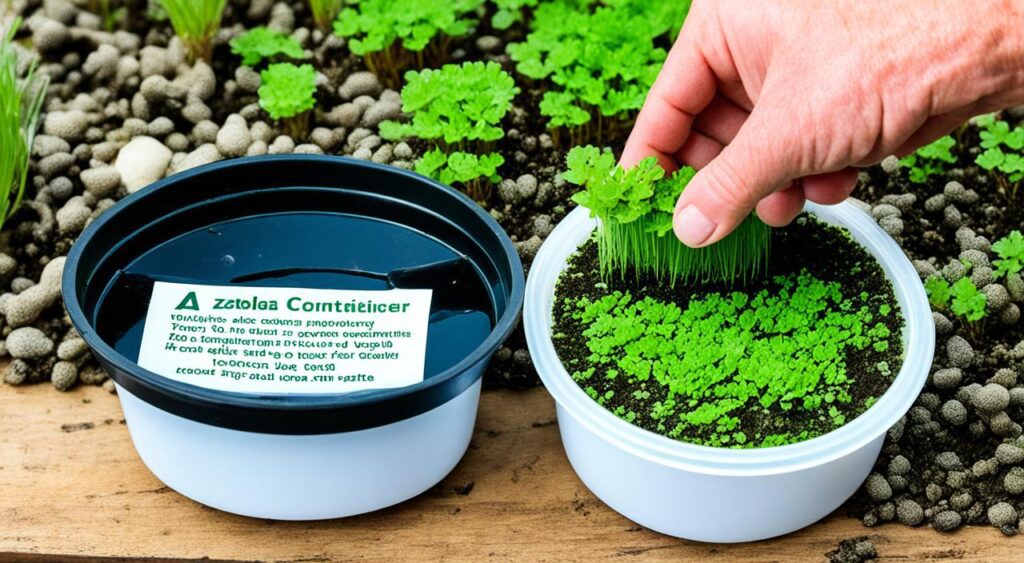
Providing proper care is crucial for the success and longevity of Azolla in your aquatic environment. This section will cover essential aspects of Azolla care, including planted tank parameters, water quality maintenance, filtration system considerations, and the importance of water flow. It will provide practical tips and guidelines to ensure optimum conditions for Azolla growth.
Planted Tank Parameters
Creating the right environment for Azolla in a planted tank is essential for its health and growth. Consider the following parameters:
- Temperature: Azolla thrives in water temperatures between 68°F and 86°F (20°C to 30°C).
- pH level: Maintain a neutral pH level between 6.5 and 7.5.
- Lighting: Azolla requires moderate to high levels of light for photosynthesis. Provide at least 10 to 12 hours of light per day.
- Substrate: Azolla does not require a substrate, as it floats on the water’s surface.
Ensuring these parameters are met will create an ideal environment for Azolla to thrive.
Water Quality
Maintaining proper water quality is essential for the health of Azolla and other aquatic organisms in your tank. Follow these tips to maintain optimal water conditions:
- Regular water changes: Replace 10-20% of the water weekly to prevent the buildup of harmful substances and maintain water clarity.
- Monitor ammonia and nitrite levels: Azolla is sensitive to high ammonia and nitrite levels. Use test kits to ensure these parameters remain within safe ranges (0 ppm for ammonia and nitrite).
- Keep nitrate levels in check: Azolla can help reduce nitrates, but monitoring and maintaining them below 20 ppm is still essential.
- Use a water conditioner: Treat tap water with a suitable water conditioner to remove chlorine and chloramine before adding it to your tank.
Maintaining optimal water quality will ensure the health and vitality of Azolla.
Filtration
Implementing an effective filtration system is crucial for maintaining water quality and preventing the accumulation of debris and waste. Consider the following filtration options:
| Filtration System | Description |
|---|---|
| Sponge Filter | A sponge filter provides mechanical and biological filtration. It is gentle on delicate Azolla and promotes the growth of beneficial bacteria. |
| Canister Filter | A canister filter offers a robust filtration system that can handle larger tanks. It provides mechanical, biological, and chemical filtration. |
| Hang-on-Back Filter | A hang-on-back filter is versatile and easy to install. It provides mechanical and biological filtration and is suitable for smaller tanks. |
Choose a filtration system that suits your tank size and the needs of your Azolla ecosystem. Regularly clean and maintain the filter to ensure optimal performance.
Flow
Proper water flow is vital for distributing nutrients and oxygen throughout the tank and preventing stagnant areas. Consider the following tips:
- Avoid strong water currents: Azolla prefers calm, gentle water movement. Direct water flows away from the surface of the Azolla plants to prevent damage.
- Use a gentle water pump or air stone: Supplement water flow with a gentle pump or air stone to ensure adequate circulation.
- Position the water pump strategically: Place the water pump in a way that provides gentle movement throughout the tank without disturbing the Azolla plants.
Maintaining proper water flow will create a healthy and balanced environment for your Azolla.
Aquarium Maintenance
Regular aquarium maintenance is crucial for the overall health and well-being of Azolla and its tank mates. You can maintain a thriving Azolla ecosystem by ensuring proper water conditions, setting up an appropriate aquarium tank, and understanding the various methods of propagating Azolla. In this section, I will provide guidelines for testing water conditions, setting up your aquarium tank, and exploring different propagation methods for Azolla.
Testing Water Conditions
Testing the water conditions in your aquarium is vital for creating a suitable environment for Azolla and other aquatic organisms. Regular water testing helps monitor pH levels, ammonia, nitrate, nitrite, and other crucial parameters. By monitoring these conditions, you can ensure that the water quality remains optimal for the growth and survival of Azolla. Conducting regular tests and promptly addressing any imbalances or issues will contribute to the overall health of your aquarium ecosystem.
How To Set Up Your Aquarium Tank
Properly setting up your aquarium tank is essential to create a favourable habitat for Azolla. Consider factors such as tank size, lighting, and filtration systems. Azolla requires adequate light for photosynthesis, so ensure your tank is placed in a well-lit area or equipped with suitable aquarium lighting. Choose a filtration system that promotes water circulation and maintains optimal water quality. By setting up your aquarium tank correctly, you can provide a conducive environment for the growth and well-being of Azolla.
Propagation Methods
Propagating Azolla is an effective way to expand your Azolla population and maintain a sustainable ecosystem. You can consider several propagation methods, including division, spore production, and water fragmentation. Division involves separating the Azolla plant into smaller portions, each capable of growing independently. Spore production occurs when Azolla releases spores, which can be collected and used to start new colonies. Water fragmentation involves breaking apart the Azolla mass into smaller fragments, which can develop into new individuals. Understanding these propagation methods will allow you to propagate Azolla and ensure its continued growth and presence in your aquarium.
| Propagation Method | Description |
|---|---|
| Division | Separating the Azolla plant into smaller portions for independent growth. |
| Spore Production | Collecting and using spores released by Azolla to start new colonies. |
| Water Fragmentation | Breaking the Azolla mass into smaller fragments for individual development. |
Health And Disease
Azolla is susceptible to specific health issues and diseases like any living organism. It is essential to monitor the health of your Azolla plants to ensure their well-being. This section will explore the signs of good health in Azolla and indicators of poor health and possible joint health issues. We will also provide insights into treatment methods for common diseases and strategies for pest control to maintain the health and vitality of your Azolla plants.
Signs Of Good Health
When Azolla is in good health, it exhibits several positive signs:
- Healthy green colouration
- Dense growth and proliferation
- No signs of yellowing or wilting
- No signs of decay or rot
- Robust and firm leaves
Signs Of Poor Health
On the other hand, Azolla may show signs of poor health if it is experiencing certain issues:
- Yellowing or browning of leaves
- Wilting or drooping appearance
- Brittle or decaying leaves
- Stunted growth or lack of proliferation
- Unusual discoloration or spots on leaves
Common Health Issues And Treatment
Azolla can encounter various health issues that may hinder its growth and vitality. Some common health issues include:
| Health Issue | Treatment |
|---|---|
| Nutrient deficiency | Supplement with appropriate fertilizers or adjust nutrient levels in the water |
| Algal overgrowth | Regularly test water parameters and make necessary adjustments to maintain suitable conditions. |
| Water quality imbalance | Regularly test water parameters and make necessary adjustments to maintain suitable conditions |
| Temperature stress | Ensure a suitable temperature range for Azolla and provide shading or cooling methods as needed. |
Plant Pests
Azolla can be affected by various pests that can hinder its growth and overall health. Some common plant pests in aquascaping that may affect Azolla include:
- Snails
- Algae-eating fish
- Insect larvae
- Other aquatic invertebrates
To control plant pests in aquascaping, it is essential to implement pest control strategies such as:
- Manual removal of pests
- Introducing natural predators
- Using organic pest control products
- Maintaining proper water quality and cleanliness
Summary
In conclusion, Azolla is a versatile aquatic fern that offers numerous benefits for ponds, aquaponics systems, and aquariums. With its ability to function as a natural biofertilizer, Azolla enhances plant growth and improves water quality. Additionally, its visually appealing foliage adds beauty to any aquatic environment.
Throughout this article, we have explored the origins and habitat of Azolla, highlighting its global distribution and adaptability to various environmental conditions. We have also discussed the morphological characteristics of Azolla, including its unique scale-like leaves.
Proper care and attention are crucial for the successful cultivation of Azolla. By considering factors such as placement, lighting, compatible tank mates, feeding, and water quality maintenance, you can ensure the health and longevity of Azolla in your aquatic setup.
In summary, Azolla is a remarkable plant that offers both aesthetic appeal and functional benefits. By following the guidelines in this article, you can create a thriving Azolla ecosystem and enjoy its many advantages to your aquatic environment.
FAQ
What is Azolla?
Azolla is a genus of aquatic ferns that belongs to the family Salviniaceae. It is characterized by its small, floating leaves that resemble duckweed or moss.
What are the benefits of Azolla?
Azolla has multiple benefits. It acts as a natural biofertilizer, enhances plant growth, improves water quality, controls algae growth, provides shade for fish, and adds beauty to aquatic environments.
Where does Azolla originate from?
Azolla is believed to have originated in the Eocene period and has a global distribution today. It can be found in freshwater habitats such as ponds, lakes, and slow-moving rivers.
What are the key morphological characteristics of Azolla?
Azolla has highly reduced and specialized leaves that are small and scale-like. The genus Azolla comprises several species, including Azolla caroliniana, which may have slight variations in morphology.
Where should I place Azolla and how much sunlight does it need?
Azolla requires still or slow-moving water with high levels of nutrients and adequate sunlight for photosynthesis. It can benefit from some shade to prevent excessive algae growth.
What fish can coexist with Azolla?
Some suitable tank mates for Azolla include small fish species like guppies, platies, and neon tetras. However, larger fish species that may harm or eat the Azolla should be avoided.
How often should I fertilize Azolla?
Azolla can derive nutrients from the water it grows in, but additional fertilization can promote its growth. It is important to feed Azolla with appropriate amounts and frequency, considering its nutritional requirements.
What are the different methods of CO2 injection for Azolla care?
There are different types of CO2 injection available for aquaria, such as liquid carbon, CO2 gas, and DIY yeast CO2. Each method has its advantages and considerations when it comes to Azolla care.
How do I take care of Azolla in my aquatic environment?
Proper care includes maintaining planted tank parameters, ensuring water quality, selecting appropriate filtration systems, and maintaining proper water flow for Azolla growth.
How do I maintain my aquarium with Azolla?
Regular aquarium maintenance involves testing water conditions, setting up a suitable aquarium tank for Azolla, and employing various propagation methods to maintain a thriving Azolla ecosystem.
What are the common health issues and diseases that Azolla can face?
Azolla can experience poor health and various diseases. It is important to monitor signs of good health, recognize signs of poor health, and address common health issues promptly. Pest control strategies may also be necessary.
What are the key points to remember about Azolla care?
Azolla care involves considering its benefits, placement and lighting requirements, suitable tank mates, feeding requirements, CO2 injection, proper care and maintenance, and recognizing signs of good health and addressing health issues.


